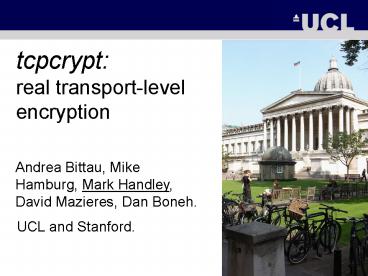tcpcrypt: real transport-level encryption - PowerPoint PPT Presentation
Title:
tcpcrypt: real transport-level encryption
Description:
tcpcrypt: real transport-level encryption Andrea Bittau, Mike Hamburg, Mark Handley, David Mazieres, Dan Boneh. UCL and Stanford. – PowerPoint PPT presentation
Number of Views:100
Avg rating:3.0/5.0
Title: tcpcrypt: real transport-level encryption
1
tcpcryptreal transport-level encryption
Andrea Bittau, Mike Hamburg, Mark Handley, David
Mazieres, Dan Boneh.
- UCL and Stanford.
2
What would it take to encrypt the vast majority
of TCP traffic?
- Performance
- Fast enough to enable by default on almost all
servers. - Authentication
- Leverage certificates, cookies, passwords, etc.,
to give best possible security for any given
setting. - Compatibility
- Works in existing networks
- Works with unmodified legacy applications
3
An observation on layering of crypto
- Encryption is a generic function.
- Independent of the semantics of the application.
- Integrity Protection is a generic function.
- What arrives should be what is sent.
- Authentication is strongly application-specific.
- Depends on the semantics of the application.
4
An observation on layering of crypto
- Observation Encryption and Integrity Protection
are lower-layer functions than Authentication. - Encryption and Integrity Protection are natural
transport-layer functions. - Cannot integrity-protect transport protocol from
above it. - Different transport sessions have different
security requirements so cannot share encryption
keys. - Authentication is application-layer.
5
Tcpcrypt
6
Tcpcrypt uses TCP options to provide deployable
transport-level encryption.
- High server performance - push complexity to
clients - Allow applications to authenticate endpoints.
- Backwards compatibility all TCP apps, all
networks, all authentication settings.
7
Tcpcrypt overview
- Extend TCP in a compatible way using TCP options.
- Existing applications use standard socket API,
just like regular TCP. - Encryption automatically enabled if both end
points support Tcpcrypt. - Extended applications can use a new getsockopt()
for authentication.
8
Push expensive operations to the client
Initial handshake No authentication. Client
decrypts. Lets servers accept connections 36x
faster than SSL
- Public-key operations can be quite assymetric.
- RSA-exp3-2048 performance
Operation Latency
Encrypt 0.26ms
Decrypt 10.42ms
9
After initial handshake, tcpcrypts Session ID
provides the hook to link application
authentication to the session.
- New getsockopt() returns non-secret Session ID
value. - Unique for every connection.
- If same on both ends, guaranteed theres no
man-in-the-middle.
10
How to check the Session ID?
- Out-of-band e.g., phone call, other secure
protocol. - PKI server signs Session ID.
- Pre-shared secret send CMAC of Session ID, keyed
with Pre-shared secret.
11
Authentication ExamplePassword-based Mutual
Authentication
- Whenever a user knows a password, mutual
authentication should be used. - Does not rely on user to spot spurious URLs.
12
Authentication ExamplePassword-based Mutual
Authentication
13
Authentication ExampleSigning a batch of
session IDs to amortize RSA costs
A, signed by amazon.com
RSA op
session ID A
14
Authentication ExampleSigning a batch of
session IDs to amortize RSA costs
session ID A
session ID C
A,B,C,D signed by amazon.com
A,B,C,D signed by amazon.com
A,B,C,D signed by amazon.com
A,B,C,D signed by amazon.com
RSA op
session ID B
session ID D
15
SSL servers RSA decrypt each clients secret
RSA op
RSA op
enc(Secret A)
enc(Secret C)
RSA op
RSA op
enc(Secret D)
enc(Secret B)
16
Tcpcryptin detail
17
Outline of Tcpcrypt key exchange
18
Key exchange is performed in the TCP connection
setup handshake.
19
Key Scheduling
20
Tcpcrypt in TCP Packets
21
Crypto state can be cached.Subsequent
connections between the same endpoints get
similar latency to regular TCP.
22
Key Scheduling 2
23
TcpcryptPerformance
24
Tcpcrypt implementations
- Linux kernel implementation 4,500 lines of code
- Portable divert-socket implementation 7000 LoC
- Tested on Windows, MacOS, Linux, FreeBSD
- Binary compatible OpenSSL library that attempts
tcpcrypt with batch-signing or falls back to SSL.
tcpcryptd
application
Network
kernel
25
Apache using tcpcrypt performs well.
- Hardware 8-core, 2.66GHz Xeon (2008-era).
- Software Linux kernel implementation.
26
Authentication over Tcpcrypt is fast.
27
What would it take to encrypt all the traffic on
the Internet, by default, all the time?
28
Why tcpcrypt?
- Want to protect TCP packet headers.
- Defend against insertion attacks, etc.
- But still traverse NATs, firewalls that rewrite
sequence numbers. - Want on-by-default encryption for existing
unmodified apps to protect against passive
easesdropping. - Fast enough to enable on all servers by default.
- Wont break - downgrades to TCP if necessary.
- Easy incremental deployment story due to
negotiation in TCP handshake.
29
Why tcpcrypt?
- Want to enable and encourage appropriate
authentication above tcpcrypt. - Cert-based, mutual auth, PAKE, etc, as
appropriate. - Eg. can support connectbyname() in a shim
library, and leverage DANE for auth. - Separation of layering provides flexibility.
- Eg. allows corporate firewall to do encryption
and app to still do authentication, so corporate
IDS still works. - tcpcryptd on firewall
- RPC to get session ID.
30
Summary tcpcrypt can enable ubiquitous transport
level encryption
- High server performance makes encryption a
realistic default. - Applications can leverage Tcpcrypt to maximize
communication security in every setting. - Incrementally deployable, compatible with legacy
apps, TCP and NATs. - http//tcpcrypt.org
31
Spare slides
32
Connection setup latency is slightly increased
due to client-side RSA decrypt.
Protocol LAN connect time (ms)
TCP 0.2
tcpcrypt cached 0.3
tcpcrypt not cached 11.3
SSL cached 0.7
SSL not cached 11.6
tcpcrypt batch sign 11.2
tcpcrypt CMAC 11.4
tcpcrypt PAKE 15.2
33
Most authentication can be done very cheaply,
once the Tcpcrypt session is established.
Protocol LAN connect time (ms)
TCP 0.2
tcpcrypt cached 0.3
tcpcrypt not cached 11.3
SSL cached 0.7
SSL not cached 11.6
tcpcrypt batch sign 11.2
tcpcrypt CMAC 11.4
tcpcrypt PAKE 15.2
34
Batch signing does not add additional latency
35
Data encryption is very fast on todays CPUs































